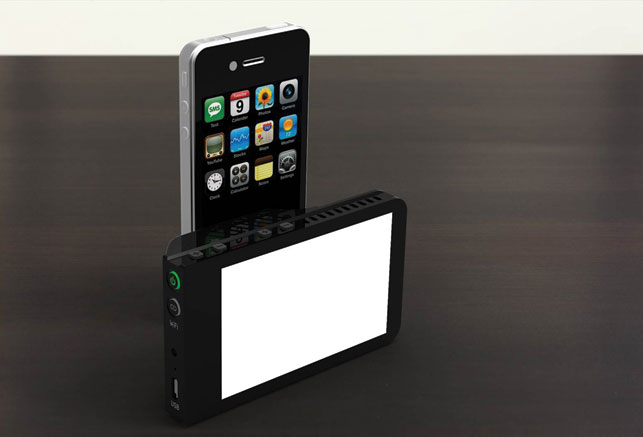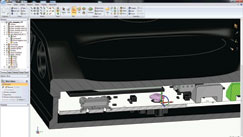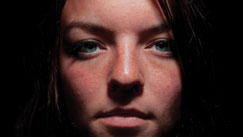Like many small electronic devices, the Kick packs a lot into a small package: Two microprocessors, a circuit board, battery and LED light display are crammed into a form the size of an iPhone.
Yet as it was made to be a portable lighting studio for use with the iPhone 4 and SLR cameras,it needed to be lightweight and compact.

Kick is a pocket-sized lighting studio for your iPhone
“The Kick is new and different, and it is a creative tool. Will people understand what it is? Will it capture their imaginations? Will they want to use it?” asks Morten Hjerde, founder of lighting technology company RiftLabs and inventor of the Kick.
In simple terms, the Kick features an LED display that connects to and is operated by an App on the user’s iPhone 4, which controls the colour, brightness and effects emitted. Being small, it can be easily carried around and used whenever the user wants to enhance the photos or videos they take.
“We set out to design a tool that’s fun, useful, creative and we really want to make it portable for as many photo enthusiasts as possible,” says Hjerde, who is also a keen photographer himself so knows all the lights, filters and gels that are required in order to take good photographs.
“The idea for it came about through frustration with how expensive and limited lights for photo and video are. They are basically glorified light bulbs with their main feature being that you can turn them on and off,” he adds.
Making light work
At its most basic, the Kick can emit straight white light if just a bit of extra light is required. But through the Kick App, users can select any colour they want from the ‘colour picker’ and then adjust the colour temperature and brightness. They can also run any of the built-in light effects such as a strobe, rainbow or lightning storm or simply create their own effects by sampling light from any video, or directly from the iPhone camera.
As Hjerde explains, “you can sample light effects pretty much like you sample music.”
Currently, the Kick is a working prototype. For the past 2.5 years, Hjerde and his small team at RiftLabs have been developing, refining and miniaturising their concept and are currently on their sixth iteration. “What started out as a professional effects light has been shrunk in size and in cost – but not in features – to an awesome pocket-sized light with a lot of in-built features,” says Hjerde.
One of the features that he is most excited about is this light streaming capability. “Light streaming is basically sampling light from a running video, amplifying it and blasting it out,” he describes. So, users can open any video from within the Kick App and position the cursor over where they want to sample the light and the Kick will stream that light.
“With the built-in effects the Kick can simulate a camp fire or a candle flicker, for example. But instead of trying to come up with every imaginable built–in light and animation, we thought why not let the user just load a video with some light effects that they want and stream that.”
Kicking off
Getting the Kick to the working prototype stage required minimal investment on the part of RiftLabs but to tool and manufacture the device will require substantial investment. Having spoken to a number of venture capitalists, Hjerde decided that he wanted to get the product to market without investors as he felt that “most investors don’t understand hardware.” So, he turned to Kickstarter.
Founded in 2008 and based in New York, Kickstarter is an online platform where owners can showcase their creative projects, from films and novels to computer games and technology products, in the hope of getting them funded through backers. They set a target minimum of funds that need to be raised and the general public then have a certain amount of time, usually 30 to 40 days, to pledge money. In most instances, this means that these backers are pre-ordering one or many of the products, depending on how much they wish to pledge.
As of April 2012, Kickstarter has had more than $175 million dollars pledged and more than 20,000 successfully funded projects.
It is an all-or-nothing funding method where projects must be fully-funded before the end of the set time or no money changes hands. If the project reaches its minimum, the owners get the money with five per cent of the funds raised taken away by Kickstarter as its fee and an additional three to five per cent taken from the Amazon payments account.
In the case of Kick, a target of $115,000 needed to be raised in 35 days. The time ends on 18 July and so far 878 backers have pledged $155,693 (as of time of writing). They have pledged amounts from $5 all the way up to $6,500 with most pledges being $139, which means they’ll get a Kick delivered to them when the device ships in October.
How it all began
When Hjerde first came up with the idea for the Kick, he started with the electronics. Having previously worked on a large and very advanced light tailored to professional photographers, the aim was to downscale that into a small and affordable device for the mass market. In a tight space he had to fit in all the electronics, battery and LEDs as well as connectors and switches.
“It’s fairly crowded in there – on one side of the PCB [printed circuit board] I only have 1.6mm clearing for the components. So, I need to fit the enclosure very tightly around the components but also try to maintain strength in the enclosure. Sometimes I have to move the components around to get features into the enclosure and make it strong,” says Hjerde.
Once Hjerde knew what electronics and components needed to go into the device, he had to model them. He initially used the 3D modelling program SketchUp but found that although it’s easy to use, it was too limiting for his requirements. He then researched what would be the best solid modeller for him and found SpaceClaim. “I do 3D modelling when I have to, it’s not my core competency in any way, and SpaceClaim is easy to use and very intuitive,” he explains.
“What I like the most is that I can just take any shape and start working with it, I don’t have to start from some 2D shape and extract it. It’s also very easy for me to try out other concepts because if I have an idea, I can easily change stuff around and if it doesn’t work out, I’ll jump back to where I was.”
Hjerde would work on the PCB design and then export that out as a 3D shape and import it into SpaceClaim directly where he could adjust the fit of the enclosure around the electronics. “In SpaceClaim I might see things that are overlapping or don’t fit properly and I’d have to go back to the PCB. So, I was constantly going back and forth between the electronics that needed to fit into the enclosure and the 3D model in SpaceClaim,” he says.
3D printing
Hjerde used a great deal of 3D printing in the development process. There were four prototypes of the enclosure made in total, each of them 3D printed. He made use of the online 3D printing services from iMaterialise and Shapeways by conveniently uploading the 3D files to their websites. “My experience is that Shapeways make better parts in general, but it usually takes three weeks to get them and that is too long for us. iMaterialise have lower quality and are much more expensive, but they send the parts in four days,” he comments.
To get it to the point where it was a manufacturable product took a great deal of hard work not only in terms of the hardware and electronics but the quality of the light too, which required a great of mathematics and complex calculations on the part of Hjerde. As he jokes, “it’s not called hardware for nothing.” In January 2012 RiftLabs also started work on the user interface and Kick App, which will be free to download.
According to Hjerde, when RiftLabs felt they were in control of all the technical issues, they decided to launch it on Kickstarter with a $115,000 funding goal to meet. The lighting device obviously resonated with people, because having launched on 14 June 2012, the very next day the Kick was almost 50 per cent funded. “We have been overwhelmed by the response to the Kick, it has far exceeded our expectations. It’s a complex product that we’ve worked hard to get right, pack useful and innovative features in to and make it both simple to use as well as affordable,”says Hjerde.
Next steps
The journey for the Kick has only really just begun. With the injection moulding of the tool recently completed, RiftLabs now has to select a manufacturer, build up a supply chain as well as distribution channels. There is still a lot to do to ensure the Kick ships in October but Hjerde is confident that the deadline will be met.
“The quality of tools for design and manufacture has grown to incredible levels. Today, it is possible for a small team like ours to create products that it would take a big company with deep pockets years to realise. We see hardware start-up companies springing up everywhere. These are exiting times!”
www.riftlabs.com

A pocket-sized lighting studio for your phone
Default








